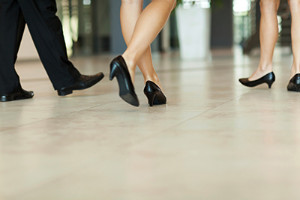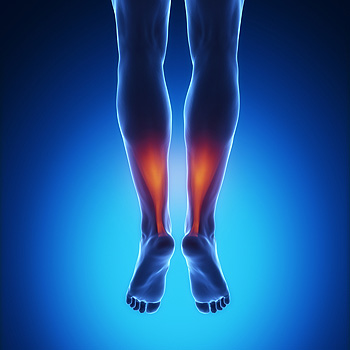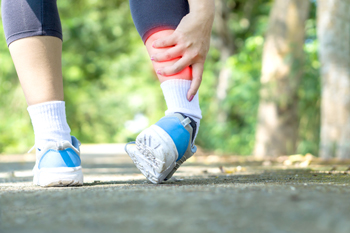Blog
Different Reasons a Bunion May Develop
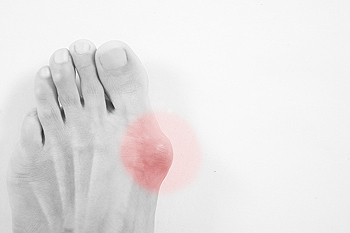 Bunions, otherwise recognized as a deformity of the big toe, can be incredibly painful when left untreated. They may easily be diagnosed by looking for a bony protrusion on the side of the big toe, and are typically more common among women and elderly patients. However, there are many reasons why someone may develop a bunion, one of those reasons being genetics. Another contributing factor may have to do with your shoes. Those who commonly wear constraining footwear, such as high heels, or cowboy boots, for extended periods of time may be more likely to develop a bunion. Injuries to the foot, as well as arthritis, can both increase your risk of developing a bunion. To help find relief from the pain bunions typically cause, it is suggested that you wear custom orthotics. For more information on treating bunions and how orthotics may help, please consult with a podiatrist for professional care.
Bunions, otherwise recognized as a deformity of the big toe, can be incredibly painful when left untreated. They may easily be diagnosed by looking for a bony protrusion on the side of the big toe, and are typically more common among women and elderly patients. However, there are many reasons why someone may develop a bunion, one of those reasons being genetics. Another contributing factor may have to do with your shoes. Those who commonly wear constraining footwear, such as high heels, or cowboy boots, for extended periods of time may be more likely to develop a bunion. Injuries to the foot, as well as arthritis, can both increase your risk of developing a bunion. To help find relief from the pain bunions typically cause, it is suggested that you wear custom orthotics. For more information on treating bunions and how orthotics may help, please consult with a podiatrist for professional care.
If you are suffering from bunions, contact Jack A. Sasiene, DPM of Texas. Our doctor can provide the care you need to keep you pain-free and on your feet.
What Is a Bunion?
A bunion is formed of swollen tissue or an enlargement of boney growth, usually located at the base joint of the toe that connects to the foot. The swelling occurs due to the bones in the big toe shifting inward, which impacts the other toes of the foot. This causes the area around the base of the big toe to become inflamed and painful.
Why Do Bunions Form?
Genetics – Susceptibility to bunions are often hereditary
Stress on the feet – Poorly fitted and uncomfortable footwear that places stress on feet, such as heels, can worsen existing bunions
How Are Bunions Diagnosed?
Podiatrists often perform two tests – blood tests and x-rays – when trying to diagnose bunions, especially in the early stages of development. Blood tests help determine if the foot pain is being caused by something else, such as arthritis, while x-rays provide a clear picture of your bone structure to your provider.
How Are Bunions Treated?
- Refrain from wearing heels or similar shoes that cause discomfort
- Select wider shoes that can provide more comfort and reduce pain
- Anti-inflammatory and pain management drugs
- Orthotics or foot inserts
- Surgery
If you have any questions, please feel free to contact our office located in Lake Jackson, TX . We offer the newest diagnostic and treatment technologies for all your foot care needs.
How to Practice Daily Foot Care
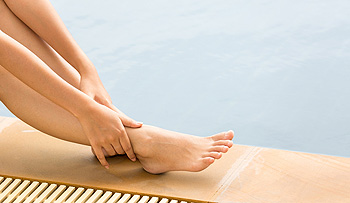 The feet are considered to be the foundation of the body, which is why it is important to take proper care of them. When this is properly accomplished, mobility and flexibility may be improved, and general aches and pains may diminish. Common foot problems that may be prevented by maintaining healthy feet can include bunions, hammertoes, and tendinitis. It is important to wear shoes that fit properly, maintain a healthy weight, and practice good foot hygiene. Additionally, it may be beneficial to perform gentle stretching techniques, which may help the feet to become strong. If additional information is needed about the importance of learning everyday foot care, please consult with a podiatrist.
The feet are considered to be the foundation of the body, which is why it is important to take proper care of them. When this is properly accomplished, mobility and flexibility may be improved, and general aches and pains may diminish. Common foot problems that may be prevented by maintaining healthy feet can include bunions, hammertoes, and tendinitis. It is important to wear shoes that fit properly, maintain a healthy weight, and practice good foot hygiene. Additionally, it may be beneficial to perform gentle stretching techniques, which may help the feet to become strong. If additional information is needed about the importance of learning everyday foot care, please consult with a podiatrist.
Everyday foot care is very important to prevent infection and other foot ailments. If you need your feet checked, contact Jack A. Sasiene, DPM from Texas. Our doctor can provide the care you need to keep you pain-free and on your feet.
Everyday Foot Care
Often, people take care of their bodies, face and hair more so than they do for their feet. But the feet are a very important aspect of our bodies, and one that we should pay more attention to. Without our feet, we would not be able to perform most daily tasks.
It is best to check your feet regularly to make sure there are no new bruises or cuts that you may not have noticed before. For dry feet, moisturizer can easily be a remedy and can be applied as often as necessary to the affected areas. Wearing shoes that fit well can also help you maintain good foot health, as well as making it easier to walk and do daily activities without the stress or pain of ill-fitting shoes, high heels, or even flip flops. Wearing clean socks with closed shoes is important to ensure that sweat and bacteria do not accumulate within the shoe. Clean socks help to prevent Athlete’s foot, fungi problems, bad odors, and can absorb sweat.
If you have any questions, please feel free to contact our office located in Lake Jackson, TX . We offer the newest diagnostic and treatment technologies for all your foot care needs.
Are Bunions Affecting Your Everyday Life?
What Benefits Are Gained From Stretching The Feet?
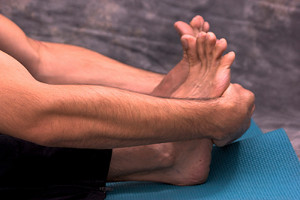 People who enjoy running or jogging as their chosen sport or hobby are generally aware of the necessity to stretch the feet and ankles. Performing correct stretching techniques may help to keep the feet healthy and strong. An effective stretch can consist of picking up small objects with your toes, and placing them in a nearby cup. This can also help to improve flexibility. Balance may be improved by standing on a smooth surface on one foot, followed by changing to an uneven surface, such as a mini trampoline. This will typically help the overall body as well as the feet and ankles. If you would like additional information about the benefits of stretching the feet, please speak with a podiatrist.
People who enjoy running or jogging as their chosen sport or hobby are generally aware of the necessity to stretch the feet and ankles. Performing correct stretching techniques may help to keep the feet healthy and strong. An effective stretch can consist of picking up small objects with your toes, and placing them in a nearby cup. This can also help to improve flexibility. Balance may be improved by standing on a smooth surface on one foot, followed by changing to an uneven surface, such as a mini trampoline. This will typically help the overall body as well as the feet and ankles. If you would like additional information about the benefits of stretching the feet, please speak with a podiatrist.
Stretching the feet is a great way to prevent injuries. If you have any concerns with your feet consult with Jack A. Sasiene, DPM from Texas. Our doctor will assess your condition and provide you with quality foot and ankle treatment.
Stretching the Feet
Being the backbone of the body, the feet carry your entire weight and can easily become overexerted, causing cramps and pain. As with any body part, stretching your feet can serve many benefits. From increasing flexibility to even providing some pain relief, be sure to give your feet a stretch from time to time. This is especially important for athletes or anyone performing aerobic exercises, but anyone experiencing foot pain or is on their feet constantly should also engage in this practice.
Great ways to stretch your feet:
- Crossing one leg over the others and carefully pull your toes back. Do 10-20 repetitions and repeat the process for each foot
- Face a wall with your arms out and hands flat against the wall. Step back with one foot and keep it flat on the floor while moving the other leg forward. Lean towards the wall until you feel a stretch. Hold for 30 seconds and perform 10 repetitions for each foot
- Be sure not to overextend or push your limbs too hard or you could risk pulling or straining your muscle
Individuals who tend to their feet by regular stretching every day should be able to minimize foot pain and prevent new problems from arising.
If you have any questions please contact our office located in Lake Jackson, TX . We offer the newest diagnostic and treatment technologies for all your foot and ankle needs.
Pregnancy and Swollen Feet
 A common ailment many pregnant women notice is swollen feet. This is often the result of hormonal changes, and an increased volume of bodily fluids. It generally begins in the second trimester, and continues until the baby is born. Additional reasons why the feet may swell during pregnancy can include spending time in warm weather, as well as standing for extended periods of time. There are methods that can be implemented which may help to reduce swelling. These can consist of elevating your feet, drinking plenty of water on a daily basis, eating healthy foods, and limiting excess salt intake. If you would like additional information about how pregnancy can affect the feet, it is suggested that you schedule a consultation with a podiatrist.
A common ailment many pregnant women notice is swollen feet. This is often the result of hormonal changes, and an increased volume of bodily fluids. It generally begins in the second trimester, and continues until the baby is born. Additional reasons why the feet may swell during pregnancy can include spending time in warm weather, as well as standing for extended periods of time. There are methods that can be implemented which may help to reduce swelling. These can consist of elevating your feet, drinking plenty of water on a daily basis, eating healthy foods, and limiting excess salt intake. If you would like additional information about how pregnancy can affect the feet, it is suggested that you schedule a consultation with a podiatrist.
Pregnant women with swollen feet can be treated with a variety of different methods that are readily available. For more information about other cures for swollen feet during pregnancy, consult with Jack A. Sasiene, DPM from Texas. Our doctor will attend to all of your foot and ankle needs.
What Foot Problems Can Arise During Pregnancy?
One problem that can occur is overpronation, which occurs when the arch of the foot flattens and tends to roll inward. This can cause pain and discomfort in your heels while you’re walking or even just standing up, trying to support your baby.
Another problem is edema, or swelling in the extremities. This often affects the feet during pregnancy but tends to occur in the later stages.
How Can I Keep My Feet Healthy During Pregnancy?
- Wearing orthotics can provide extra support for the feet and help distribute weight evenly
- Minimize the amount of time spent walking barefoot
- Wear shoes with good arch support
- Wear shoes that allow for good circulation to the feet
- Elevate feet if you experience swelling
- Massage your feet
- Get regular, light exercise, such as walking, to promote blood circulation to the feet
If you have any questions, please feel free to contact our office located in Lake Jackson, TX . We offer the newest diagnostic and treatment technologies for all your foot care needs.
What Leads to a Gout Attack?
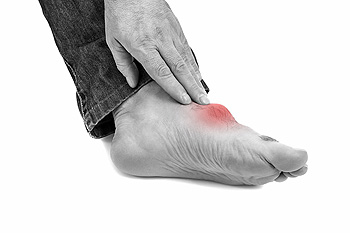 Arthritis can develop in many different forms. The build up of crystals that form in and around the joints is a symptom of arthritis commonly referred to as gout. Gout is particularly painful and most commonly affects the big toe. Some symptoms that indicate you might have developed gout include heat, tenderness, pain, swelling, and redness of the affected joint. You may also notice that the skin over the affected joint may appear shiny, and can begin to peel overtime. Gout typically develops due to an increase of urate crystals that spill out from the cartilage and into the space between the bones and joints. This build up of crystals can lead to what is referred to as a gout attack. For information about treating gout and relieving its symptoms, we recommend that you consult with a podiatrist for professional care and advice.
Arthritis can develop in many different forms. The build up of crystals that form in and around the joints is a symptom of arthritis commonly referred to as gout. Gout is particularly painful and most commonly affects the big toe. Some symptoms that indicate you might have developed gout include heat, tenderness, pain, swelling, and redness of the affected joint. You may also notice that the skin over the affected joint may appear shiny, and can begin to peel overtime. Gout typically develops due to an increase of urate crystals that spill out from the cartilage and into the space between the bones and joints. This build up of crystals can lead to what is referred to as a gout attack. For information about treating gout and relieving its symptoms, we recommend that you consult with a podiatrist for professional care and advice.
Gout is a painful condition that can be treated. If you are seeking treatment, contact Jack A. Sasiene, DPM from Texas. Our doctor will treat your foot and ankle needs.
What Is Gout?
Gout is a form of arthritis that is characterized by sudden, severe attacks of pain, redness, and tenderness in the joints. The condition usually affects the joint at the base of the big toe. A gout attack can occur at any random time, such as the middle of the night while you are asleep.
Symptoms
- Intense Joint Pain - Usually around the large joint of your big toe, and it most severe within the first four to twelve hours
- Lingering Discomfort - Joint discomfort may last from a few days to a few weeks
- Inflammation and Redness -Affected joints may become swollen, tender, warm and red
- Limited Range of Motion - May experience a decrease in joint mobility
Risk Factors
- Genetics - If family members have gout, you’re more likely to have it
- Medications - Diuretic medications can raise uric acid levels
- Gender/Age - Gout is more common in men until the age of 60. It is believed that estrogen protects women until that point
- Diet - Eating red meat and shellfish increases your risk
- Alcohol - Having more than two alcoholic drinks per day increases your risk
- Obesity - Obese people are at a higher risk for gout
Prior to visiting your podiatrist to receive treatment for gout, there are a few things you should do beforehand. If you have gout you should write down your symptoms--including when they started and how often you experience them, important medical information you may have, and any questions you may have. Writing down these three things will help your podiatrist in assessing your specific situation so that he or she may provide the best route of treatment for you.
If you have any questions, please feel free to contact our office located in Lake Jackson, TX . We offer the newest diagnostic and treatment technologies for all your foot care needs.
Work Shoes for the Job
There are several foot conditions that can occur if your job consists of standing for the majority of the day. Your feet may feel achy, and cracked heels may develop if you stand on hard surfaces. Additionally, your feet may become swollen, and blisters may form from wearing shoes that do not fit correctly. There are several factors to look for in a work shoe. These can consist of choosing shoes that are enclosed and fastened, have adequate cushioning, and have a wide heel for ankle support. Additionally, it is important to make sure there is ample room in the top of the shoe, as this may help to avoid friction. It can be beneficial to sit down as often as possible, which may help the heels to feel better. If you would like more information about how to care for your feet while working during the day, please consult with a podiatrist.
While working on the feet, it is important to take the proper care of them. For more information about working on your feet, contact Jack A. Sasiene, DPM from Texas. Our doctor will treat your foot and ankle needs.
Working on Your Feet
Standing on your feet for long periods of time can cause stress and pain in your feet. Your whole body may experience change in terms of posture, back pain, bunions, callouses and or plantar warts. There are ways to avoid these conditions with proper foot care, smart choices and correct posture.
Positive Changes
Negative heeled shoe – Choosing this shoe type places the heel slightly lower than the ball of the foot. These are great for overall foot health. Find shoes that fit you correctly.
Go barefoot – Our feet were not designed to be enclosed for all hours of the day. Try to periodically expose your feet to air.
Eliminate Pain
Foot Exercises – Performing simple exercises, incorporating yoga and doing stretches are beneficial. This will allow increased blood flow to the area and muscles of the foot.
Achilles tendon – Stretching the foot out flat on the floor will relax the calf muscles and tendon. These exercises can be performed almost anywhere. Make sure you add these exercises to your daily regimen.
With a little bit of this information and knowing more about foot health, you will notice changes. Foot stretches and proper footwear will help with pain and prevent further issues.
If you have any questions please contact our office located in Lake Jackson, TX . We offer the newest diagnostic and treatment technologies for all your foot and ankle needs.
Are You Suffering From Ingrown Toenails?
How to Help Seniors Care for Their Feet
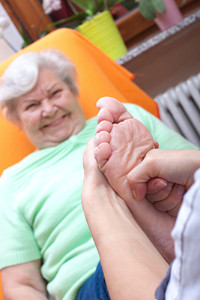 Elderly people may have difficulty in maintaining proper foot care. This may be a result of being unable to bend down to correctly trim the toenails. Additionally, it may be challenging to wash and dry the feet thoroughly, which may lead to the development of painful foot conditions. Seniors may have trouble seeing any existing wounds on the feet, and the skin may become dry and cracked. It may be beneficial if a caregiver can help older people to properly manage everyday foot care by gently massaging their feet, followed by using a moisturizing lotion. If you have questions about how to take care of elderly feet, it is suggested that you speak to a podiatrist.
Elderly people may have difficulty in maintaining proper foot care. This may be a result of being unable to bend down to correctly trim the toenails. Additionally, it may be challenging to wash and dry the feet thoroughly, which may lead to the development of painful foot conditions. Seniors may have trouble seeing any existing wounds on the feet, and the skin may become dry and cracked. It may be beneficial if a caregiver can help older people to properly manage everyday foot care by gently massaging their feet, followed by using a moisturizing lotion. If you have questions about how to take care of elderly feet, it is suggested that you speak to a podiatrist.
Proper foot care is something many older adults forget to consider. If you have any concerns about your feet and ankles, contact Jack A. Sasiene, DPM from Texas. Our doctor can provide the care you need to keep you pain-free and on your feet.
The Elderly and Their Feet
As we age we start to notice many changes in our body, but the elder population may not notice them right away. Medical conditions may prevent the elderly to take notice of their foot health right away. Poor vision is a lead contributor to not taking action for the elderly.
Common Conditions
- Neuropathy – can reduce feeling in the feet and can hide many life-threatening medical conditions.
- Reduced flexibility – prevents the ability of proper toenail trimming, and foot cleaning. If left untreated, it may lead to further medical issues.
- Foot sores – amongst the older population can be serious before they are discovered. Some of the problematic conditions they may face are:
- Gouging toenails affecting nearby toe
- Shoes that don’t fit properly
- Pressure sores
- Loss of circulation in legs & feet
- Edema & swelling of feet and ankles
Susceptible Infections
Diabetes and poor circulation can cause general loss of sensitivity over the years, turning a simple cut into a serious issue.
If you have any questions, please feel free to contact our office located in Lake Jackson, TX . We offer the newest diagnostic and treatment technologies for all your foot care needs.
Treating Ingrown Toenails
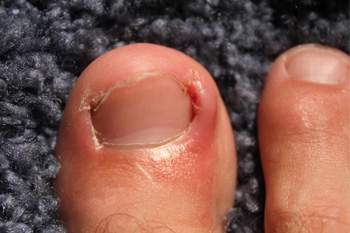 Ingrown toenails can be both uncomfortable and painful if left untreated. One of the most common causes of their development is hereditary or genetic factors. The curvature of your toenails are passed down to you, so if you have family members that are prone to getting ingrown toenails, it is likely you may run the same risk. Cutting your toenails too short is another cause of getting an ingrown toenail. If they are cut too short, the skin around the toe will adapt, forming an ingrown toenail. It is also advised you do not cut your toenails on an angle, rather trim them straight across. If you are experiencing pain, a podiatrist may suggest a splint to help stop the nail from growing any further into your skin. In more severe cases, a podiatrist may suggest surgery and full removal of the toenail. To help ease the pain, it’s recommended that you soak your feet in epsom salt, as this will also help to get rid of any bacteria under the toenails. For professional care we recommend you consult with a podiatrist who can advise you on the best course of treatment for your case.
Ingrown toenails can be both uncomfortable and painful if left untreated. One of the most common causes of their development is hereditary or genetic factors. The curvature of your toenails are passed down to you, so if you have family members that are prone to getting ingrown toenails, it is likely you may run the same risk. Cutting your toenails too short is another cause of getting an ingrown toenail. If they are cut too short, the skin around the toe will adapt, forming an ingrown toenail. It is also advised you do not cut your toenails on an angle, rather trim them straight across. If you are experiencing pain, a podiatrist may suggest a splint to help stop the nail from growing any further into your skin. In more severe cases, a podiatrist may suggest surgery and full removal of the toenail. To help ease the pain, it’s recommended that you soak your feet in epsom salt, as this will also help to get rid of any bacteria under the toenails. For professional care we recommend you consult with a podiatrist who can advise you on the best course of treatment for your case.
Ingrown toenails may initially present themselves as a minor discomfort, but they may progress into an infection in the skin without proper treatment. For more information about ingrown toenails, contact Jack A. Sasiene, DPM of Texas. Our doctor can provide the care you need to keep you pain-free and on your feet.
Ingrown Toenails
Ingrown toenails are caused when the corner or side of a toenail grows into the soft flesh surrounding it. They often result in redness, swelling, pain, and in some cases, infection. This condition typically affects the big toe and may recur if it is not treated properly.
Causes
- Improper toenail trimming
- Genetics
- Improper shoe fitting
- Injury from pedicures or nail picking
- Abnormal gait
- Poor hygiene
You are more likely to develop an ingrown toenail if you are obese, have diabetes, arthritis, or have any fungal infection in your nails. Additionally, people who have foot or toe deformities are at a higher risk of developing an ingrown toenail.
Symptoms
Some symptoms of ingrown toenails are redness, swelling, and pain. In rare cases, there may be a yellowish drainage coming from the nail.
Treatment
Ignoring an ingrown toenail can have serious complications. Infections of the nail border can progress to a deeper soft-tissue infection, which can then turn into a bone infection. You should always speak with your podiatrist if you suspect you have an ingrown toenail, especially if you have diabetes or poor circulation.
If you have any questions, please feel free to contact our office located in Lake Jackson, TX . We offer the newest diagnostic and treatment technologies for all your foot care needs.
More...
How Poor Circulation Impacts the Feet
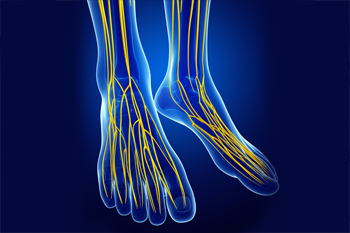 Poor circulation of the feet is a typical condition that develops among patients dealing with diabetes. Some warning signs indicating you may have poor circulation include: cramping of the feet, slow healing sores, discoloration of the legs or feet, an abnormal temperature of the legs or feet, and possible hair loss of the legs or feet. Poor circulation can be particularly dangerous as it often causes a loss of feeling in the feet. Because of this, if a wound develops on a person’s foot and they don’t feel it, they may run the risk of developing an infection or another type of foot complication that is more severe. Checking the feet daily for any abnormalities or wounds is especially important for those with diabetes, as small cuts or scrapes run the risk of turning into something more severe if left untreated. For more information about poor circulation, we recommend you consult with a podiatrist for a proper diagnosis and advised treatment plan.
Poor circulation of the feet is a typical condition that develops among patients dealing with diabetes. Some warning signs indicating you may have poor circulation include: cramping of the feet, slow healing sores, discoloration of the legs or feet, an abnormal temperature of the legs or feet, and possible hair loss of the legs or feet. Poor circulation can be particularly dangerous as it often causes a loss of feeling in the feet. Because of this, if a wound develops on a person’s foot and they don’t feel it, they may run the risk of developing an infection or another type of foot complication that is more severe. Checking the feet daily for any abnormalities or wounds is especially important for those with diabetes, as small cuts or scrapes run the risk of turning into something more severe if left untreated. For more information about poor circulation, we recommend you consult with a podiatrist for a proper diagnosis and advised treatment plan.
Poor circulation is a serious condition and needs immediate medical attention. If you have any concerns with poor circulation in your feet contact Jack A. Sasiene, DPM of Texas. Our doctor will treat your foot and ankle needs.
Poor Circulation in the Feet
Poor blood circulation in the feet and legs is can be caused by peripheral artery disease (PAD), which is the result of a buildup of plaque in the arteries.
Plaque buildup or atherosclerosis results from excess calcium and cholesterol in the bloodstream. This can restrict the amount of blood which can flow through the arteries. Poor blood circulation in the feet and legs are sometimes caused by inflammation in the blood vessels, known as vasculitis.
Causes
Lack of oxygen and oxygen from poor blood circulation restricts muscle growth and development. It can also cause:
- Muscle pain, stiffness, or weakness
- Numbness or cramping in the legs
- Skin discoloration
- Slower nail & hair growth
- Erectile dysfunction
Those who have diabetes or smoke are at greatest risk for poor circulation, as are those who are over 50. If you have poor circulation in the feet and legs it may be caused by PAD and is important to make changes to your lifestyle in order to reduce risk of getting a heart attack or stroke. Exercise and maintaining a healthy lifestyle will dramatically improve conditions.
As always, see a podiatrist as he or she will assist in finding a regimen that suits you. A podiatrist can also prescribe you any needed medication.
If you have any questions, please feel free to contact our office located in Lake Jackson, TX . We offer the newest diagnostic and treatment technologies for all your foot care needs.
Painful Achilles Tendon Injury
The Achilles tendon is comprised of two muscles in the calf, and is considered to be the strongest tendon in the body. Injuries to this tendon can be caused by participating in running and jumping activities. Additionally, they can occur as a result of wearing flip flops in the warmer weather, which may cause the Achilles tendon to stretch further than it normally would. Common symptoms that are typically felt with this type of injury may consist of the inability to point and flex the toes, soreness that is felt upon arising in the morning, and difficulty walking. Moderate relief may be found when the proper shoes are worn, and if gentle stretches are implemented into a daily routine. If you have injured your Achilles tendon, it is strongly advised that you consult with a podiatrist who can properly treat this condition.
Achilles tendon injuries need immediate attention to avoid future complications. If you have any concerns, contact Jack A. Sasiene, DPM of Texas. Our doctor can provide the care you need to keep you pain-free and on your feet.
What Is the Achilles Tendon?
The Achilles tendon is a tendon that connects the lower leg muscles and calf to the heel of the foot. It is the strongest tendon in the human body and is essential for making movement possible. Because this tendon is such an integral part of the body, any injuries to it can create immense difficulties and should immediately be presented to a doctor.
What Are the Symptoms of an Achilles Tendon Injury?
There are various types of injuries that can affect the Achilles tendon. The two most common injuries are Achilles tendinitis and ruptures of the tendon.
Achilles Tendinitis Symptoms
- Inflammation
- Dull to severe pain
- Increased blood flow to the tendon
- Thickening of the tendon
Rupture Symptoms
- Extreme pain and swelling in the foot
- Total immobility
Treatment and Prevention
Achilles tendon injuries are diagnosed by a thorough physical evaluation, which can include an MRI. Treatment involves rest, physical therapy, and in some cases, surgery. However, various preventative measures can be taken to avoid these injuries, such as:
- Thorough stretching of the tendon before and after exercise
- Strengthening exercises like calf raises, squats, leg curls, leg extensions, leg raises, lunges, and leg presses
If you have any questions please feel free to contact our office located in Lake Jackson, TX . We offer the newest diagnostic tools and technology to treat your foot and ankle needs.
Ankle Sprains Are a Common Reason for Ankle Pain
Many types of ankle pain can be caused by an injury, or from various medical conditions that can include arthritis. Research has indicated that ankle sprains are the most common causes of ankle pain. When your foot rolls to one side, the ligaments may become torn or stretched beyond their normal limits. This is known as a lateral sprain, and may take up to two weeks to properly heal. Patients have found that elevating the affected foot may reduce a portion of any existing swelling. Additionally, it is beneficial to wrap the ankle in an elastic bandage, which may provide the necessary support as the healing process takes place. After it is healed, practicing specific stretches can help to strengthen the overall foot. If you have ankle pain for any reason, it is advised that you consult with a podiatrist who can properly diagnosis and treat this type of pain.
Ankle pain can be caused by a number of problems and may be potentially serious. If you have ankle pain, consult with Jack A. Sasiene, DPM from Texas. Our doctor will assess your condition and provide you with quality foot and ankle treatment.
Ankle pain is any condition that causes pain in the ankle. Due to the fact that the ankle consists of tendons, muscles, bones, and ligaments, ankle pain can come from a number of different conditions.
Causes
The most common causes of ankle pain include:
- Types of arthritis (rheumatoid, osteoarthritis, and gout)
- Ankle sprains
- Broken ankles
- Achilles tendonitis
- Achilles tendon rupture
- Stress fractures
- Bursitis
- Tarsal tunnel syndrome
- Plantar fasciitis
Symptoms
Symptoms of ankle injury vary based upon the condition. Pain may include general pain and discomfort, swelling, aching, redness, bruising, burning or stabbing sensations, and/or loss of sensation.
Diagnosis
Due to the wide variety of potential causes of ankle pain, podiatrists will utilize a number of different methods to properly diagnose ankle pain. This can include asking for personal and family medical histories and of any recent injuries. Further diagnosis may include sensation tests, a physical examination, and potentially x-rays or other imaging tests.
Treatment
Just as the range of causes varies widely, so do treatments. Some more common treatments are rest, ice packs, keeping pressure off the foot, orthotics and braces, medication for inflammation and pain, and surgery.
If you have any questions please feel free to contact our office located in Lake Jackson, TX . We offer the newest diagnostic tools and technology to treat your foot and ankle needs.

